

Paying tribute
Idon’t think any of us who attended IBC last month expected one of the biggest news stories of recent years to break as we were arriving in Amsterdam. The death of Queen Elizabeth II meant that for many this year’s IBC was a lot shorter than they were expecting.
Like everyone, I switched the TV on as soon as I arrived at my hotel in order to find out what was happening. After first tuning to CNN I then found BBC One and followed its coverage. As always, at times of major news events, it’s TV that we all turn to. And that was again the case whether you were in Amsterdam, London, New York or Sydney.
For live breaking news there is no better medium than television, and in particular, live linear television.
TV cameras were pretty much everywhere to cover the Queen’s journey from Balmoral to Windsor, via Edinburgh and London. Every single moment was covered without a hitch. That’s down to the fantastic work behind the scenes by crews across the UK. And as broadcasters around the world descended for the funeral itself, again UK production teams and technology stood up to the demand.
I was delighted to see on-camera talent pay tribute to those working behind the camera who are so often forgotten. It’s only when something goes wrong that they usually get a mention, but their work absolutely deserves to be singled out for praise just as much as those who were providing commentary and analysis.
As we move forward, TV will again play a
was delighted to see on-camera talent pay tribute to those working behind the camera who
often
Coverage of the Queen’s death was like nothing TV viewers had ever seen before. Since the Queen came to the throne in 1952, television, and the way we watch it, has completely changed. TV audiences saw very little of George VI’s funeral, mostly because very few households even had a television set. We’ve all seen the pictures of families crowded around huge sets in the corner of the room the following year to watch the Queen’s coronation. Fast forward 70 years later and we can watch TV at home, on the train, or in the office, something I’m sure the teams who worked on the Coronation would never have dreamed of.
major role in King Charles’ coronation next year. I suspect planning has been underway for quite some time. While we’re often told that viewers are moving away from linear, it will once again be the more traditional ways of viewing TV that will capture viewers when the time comes. And, as always, everyone working behind the camera will be as prepared as those in front. n
JENNY
www.tvbeurope.com

MANAGEMENT
ADVERTISING SALES
SUBSCRIBER CUSTOMER
ARCHIVES
LICENSING/REPRINTS/PERMISSIONS




Leveraging the use of the cloud for the media industry
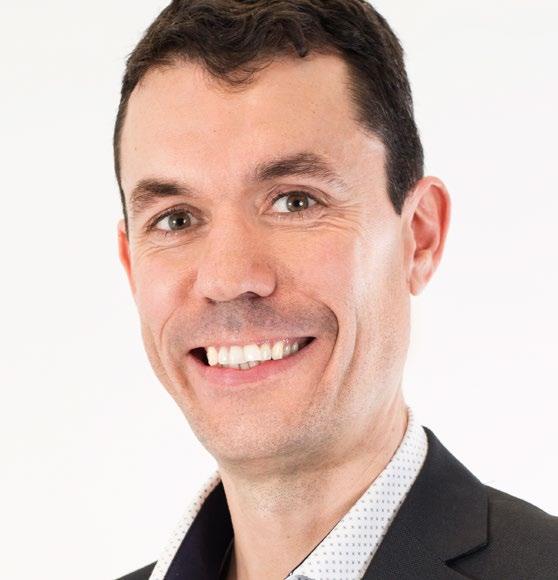 By Julian Fernandez-Campon, CTO, Tedial
By Julian Fernandez-Campon, CTO, Tedial
Attending IBC 2022, it was clear to see how far the media industry has transitioned to managing content in the cloud. It’s also clear to see that no two cloud deployments, which have become a must-have for all software vendors in one way or another, are the same, and it’s interesting that nearly all claim to be cloud-native. But what does cloud-native actually mean? According to GitLab, one of the biggest devops platforms, “Cloud-native is a term used to describe applications that are built to run in a cloud computing environment. These applications are designed to be scalable, highly available, and easy to manage.”
By contrast, traditional applications that are not cloud-native are often deployed in the cloud in ‘virtual machines’ and so do not take full advantage of cloud benefits. Between these two positions, there is a wide greyscale range of applications that claim to be cloud-native as they are in the cloud and containerised but also do not take full advantage of the benefits. The M&E industry has challenges that need to be addressed to ensure a real cloud-native solution.
TAKING ADVANTAGE OF THE CLOUD Cloud services have many advantages: quick time to market, elasticity, accessibility, security to name the most relevant, but for a platform to be able to offer all these benefits the applications need to be architectured and deployed with a cloud-based mindset that can be summarised as:
• Use of containers.
• Cost-efficiency, using, when possible, services in the cloud (database, indexing/searching, storage) to maximise ROI
• Elasticity, to be able to scale up and down according to processing needs
• Visibility, to give customers all the metrics to be able to optimise the operation according to the business needs. Sometimes using fewer resources is sufficient and there is no need to spend money to increase speed
• Future-proof, simple upgrades and evolution to meet future needsMost of the software that is in the cloud is containerised but not all meet all of these requirements, particularly in the M&E industry
BUILDING THE CONTENT SUPPLY CHAIN
The M&E industry has specific requirements that make the cloud operation more complex, particularly when building the content supply
chain. The first is media management, all the applications need to access the media in an efficient way. The second is the integration of all the applications as part of the ecosystem to be able to implement the content supply chain. These two requirements make the ‘cloud-native for media’ even more challenging than with other services such as email, mobile apps or any other we consume on a daily basis. This is particularly true with integrations, as the software that is containerised needs to be decoupled from the plug-ins. Otherwise, microservices will become monsters with a lot of plug-ins inside and every little upgrade in one integration will force the microservice to be upgraded too, with the risk that implies.
In addition, the interfaces for all the plugins need to be unified because if they’re not, a change in one interface, even if decoupled as a plug-in, will force the microservice to be upgraded too, and same for the metadata that is sent and received as part of the integration.
Business processes that are used to implement the content supply chain also need to be decoupled as packages, and be easy to define, maintain and upgrade. That’s why having a true media integration platform that abstracts the interface and the datamodel is key to having a real ‘cloud-native for media’ deployment.
FUTURE-PROOF
Broadcasters want solutions that work now and that are flexible enough to evolve and adapt to future needs. Taking cloud deployments for media to the next level implies that upgrades are easy, low risk, can be done automatically or by non-technical people, and of course are not vendor dependent. Therefore, cloud-native applications for media need to implement a true CI/CD process not only for the software but also all the integration plugins and workflows.
This must be achieved by defining a repository where all the microservices, plugins and workflows are delivered and the deployments are upgraded only with the elements they need, minimising the risk, ensuring business continuity, maximising ROI and minimising the total cost of ownership as there is no dependence on the vendor.
Tedial’s smartWork NoCode cloud-native media integration platform is built with microservices and kubernetes to provide future-proofing and scalability, both of media operations and resources. n

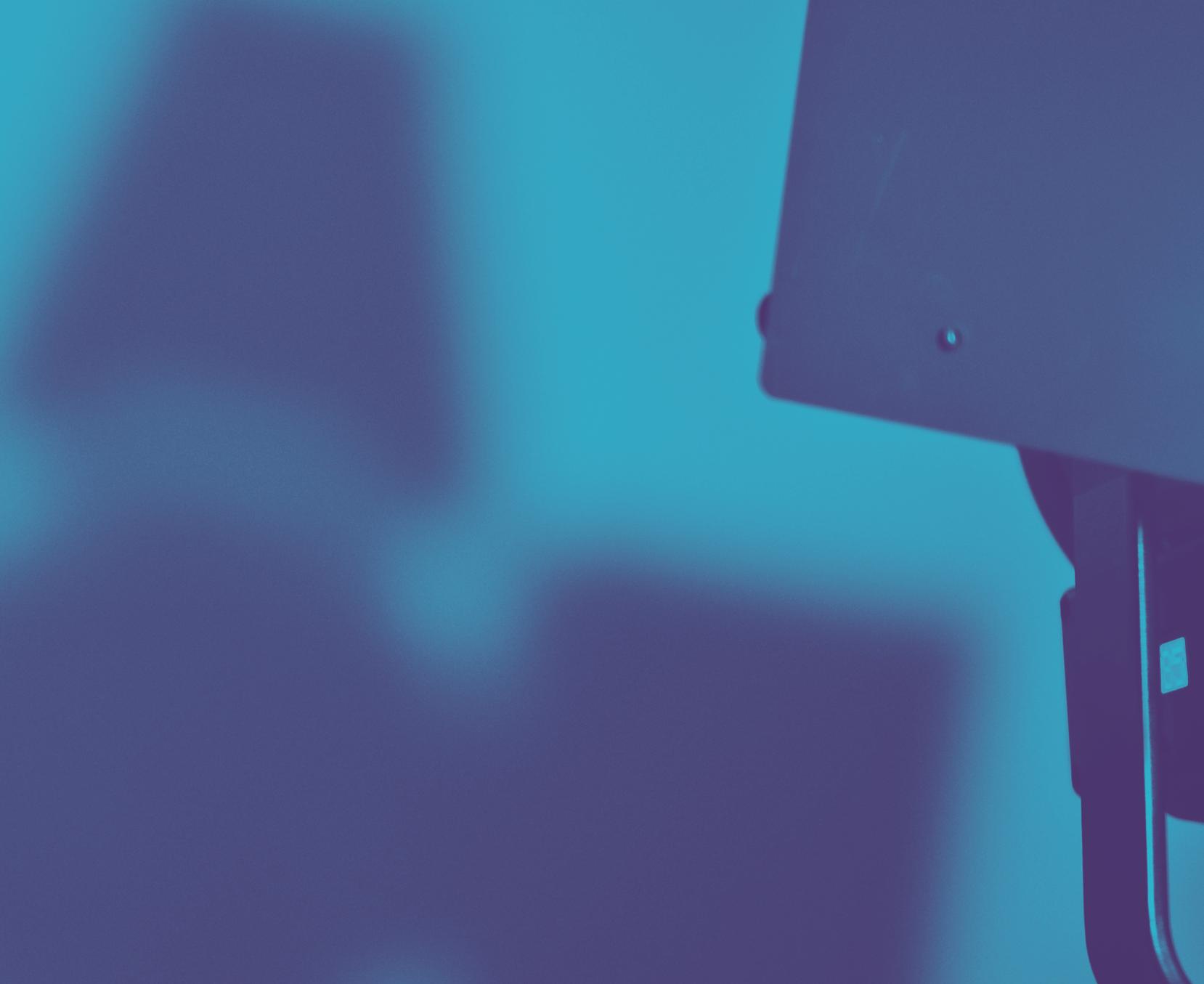
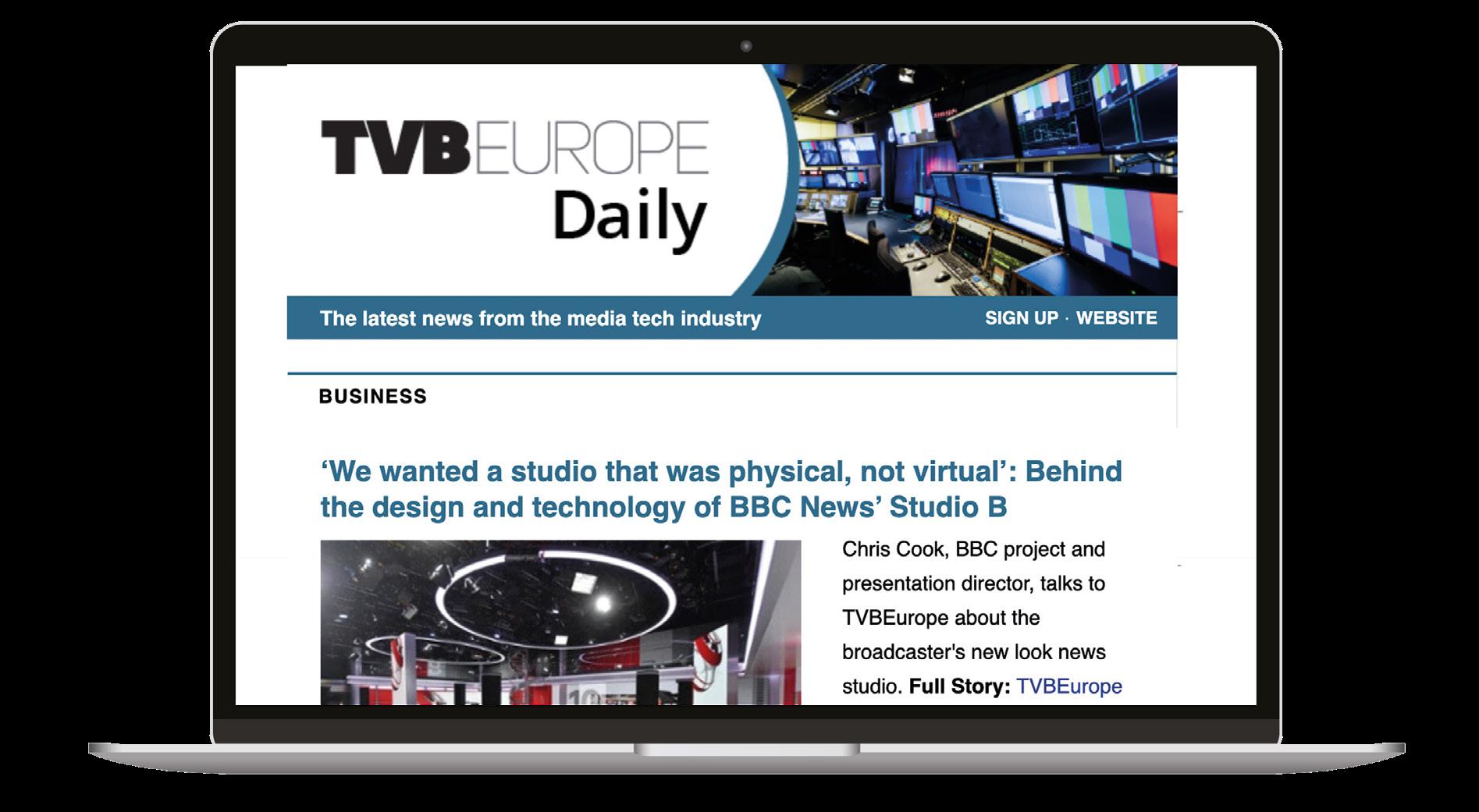



Black Box® Black Box Emerald DESKVUE CGI OpenMedia NewsBoard
Black Box Emerald DESKVUE allows visitors to the company’s IBC stand 8.F42 to catch a glimpse of the not-so-distant future of KVM. The company will demonstrate a completely new way for users to create their own individual workspace with the game-changing Black Box Emerald DESKVUE.
The demo will highlight how users can access up to sixteen different systems simultaneously – whether they are computers, servers or virtual machines. All systems are displayed as individual windows on up to four 4K or large curved (5K) monitors. Users can arrange these windows in any way and thus create a comfortable and easy-to-use workspace tailored to their individual tasks, including USB 3/2/1 and audio connectivity.
Cinegy Channel-in-the-Cloud

The latest iteration of Cinegy Channel-in-theCloud, version 22.2, brings together the Cinegy Air PRO playout and automation solution, Cinegy Multiviewer and the Cinegy Capture acquisition and transcode system in a single bundle available on AWS (Amazon Web Services) and Microsoft Azure Marketplace.

Cinegy Channel-in-the-Cloud gives broadcasters, corporations - or indeed anyone with a valid credit card – a vastly simplified way to instantly get single or multiple channels of SD, HD and/or Ultra HD 4K playout up and running in the cloud within minutes. The package delivers automation, playout, branding, master control, analytics, and alarms in a single, ready-to-launch cloud instance with hourly pay-as-you-go pricing.

Dejero Dejero EnGo 3x
The Dejero EnGo 3x unlocks the full potential of 5G technology, providing uninterrupted connectivity, high bandwidth internet access, 4K UHD video transmission, and multi-camera support, even in the harshest of environments, remotest of locations or crowded areas.

What makes the EnGo 3x stand out is its unique RF and antenna architecture which significantly improves throughput and spectral efficiency. Quadrupling the number of MIMO (multiple-input, multiple-output) antennas to four per modem–without compromising performance and reliability–is no easy feat in such a small, portable transmitter. The EnGo 3x 5G modems support a broad range of cellular bands used by carriers in the US, Canada, Australia, China, Korea, and Latin America that other 5G mobile transmitters can’t connect to.
EVS EVS Shield (firewall management tool/platform)

Leveraging 25+ years of broadcast experience, and based on the latest Zero Trust and microsegmentation security policies, the EVS Shield is a new firewall management tool designed with the specific needs and challenges of live video production in mind. It is a simple combination of a manager and a multiplatform agent, which helps maintain complete network security by allowing users to easily deploy and enforce firewall rules on every device within the same EVS network. With the EVS Shield, broadcasters are able to implement Zero Trust principles onto their network with a tool specifically designed for their unique requirements.
The new OpenMedia NewsBoard by CGI includes a modern and unified web user interface, it’s the ‘go-to’ cross-media planning tool that enables journalists and editorial teams to organize their story production process directly from everywhere. It features a fully customisable and open widget architecture that allows journalists in large teams to stay flexible, adapting views to their individual needs. Its modern, unified webbased user interface for journalists and editorial teams dynamizes the collaboration process.
NewsBoard’s dashboard solution helps journalists and editorial teams organise the story creation process from research to planning and distribution, all within its unified web-based user interface.

Dalet Dalet Flex for teams
Getting high-value content to audiences is not getting any easier. In a world where remote work is increasingly common, and media is consumed through dozens of different platforms, it can be hard to keep up. Large libraries can be spread across multiple locations, on-premises or in the cloud; and making sure the right content, in the right version and format, ends up on the right platform at the right time could give headaches to anyone.
Dalet Flex for teams, a SaaS solution based on the Dalet Flex media workflow platform, democratizes key media logistics use cases such as library management and multiplatform content distribution. Hosted and managed by Dalet, customers can eliminate overhead and better control budgets, with the elasticity and scalabilityof the cloud.
Evertz Ease Live Interactive Graphics

Ease Live drives engagement and monetisation opportunities by the gamification of the viewer experience. Ease Live overlays graphical content onto live streams, allowing the viewer to interact with in-game live statistics, watch parties, polls/trivia, and sponsored betting and wagers without having to leave the event. With interactive graphics, content and rights owners can customize the user experience to increase both the level of user engagement and the length of time of engagement.
As the cost of content rights becomes more expensive and the competition for audiences grows, content providers are looking for new ways to drive engagement and monetize content. Ease Live is engages fans using three modes – stats, watch and play.
Haivision Haivision Pro460

The Haivision Pro460 (the new addition to its video streaming solutions portfolio with the acquisition of Aviwest) is a mobile video encoder and transmitter that addresses the challenges that broadcasters face in expanding their remote production for live events. Designed for live video producers (sports, concerts, etc.) and newsgathering professionals, users can enjoy advanced video delivery performance from any location anywhere in the world.
Housing six globally compliant 5G modems and patented highefficiency antennas to ensure high-speed transmission, the Pro460 provides robust, error-free transmission over any network (i.e., cellular, satellite, IP leased line, or the public internet), ensuring low end-to-end latency – down to 0.5 seconds – thanks to AVIWEST’s two-time Emmy® Award-winning SST (Safe Stream Transport) technology.
Hitomi Broadcast MatchBox Latency iSIZE Technologies BitClear

Hitomi Broadcast’s MatchBox now measures the delay between an event happening in real life and seeing it in picture - latency. Taken either from the front of multiple cameras or at various points through the broadcast chain, readings are displayed in real time with milli-second accuracy. MatchBox Latency further strengthens Hitomi’s applications for remote and virtual productions.
Typically, live broadcast workflows add delay which can vary each time. Different paths need to be synchronised for a seamless viewer experience. For example, in golf coverage graphics that show the trajectory of the ball can take up to a second to generate. If this latency is overcompensated for, you see the flight of the ball before the golfer hits it.
User-generated content (UGC) that is viewed by millions of people has been re-shared and reuploaded numerous times, which tends to make it very degraded due to multiple transcoding iterations happening on non-optimized platforms, e.g., mobile phones transcoding for bandwidth-constrained uploads. For social media or UGC distribution and streaming companies, presenting video content in as high quality as possible is vital to keeping audiences engaged and maximize their video asset.
An AI-based video processing technology, BitClear makes unwatchable videos watchable by removing compression artifacts (blurring, blocking, etc) from user-generated, or heavily compressed content.
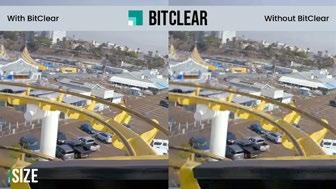
LiveU LU810 multi-camera encoder LucidLink Filespaces
LiveU launched the breakthrough LU810 5G 4K four-camera rackmount encoder at IBC 2022.

Ideal for live sports productions, LiveU’s new vehicle and fixed location encoders - there’s also the single camera LU610S - enable mission-critical live video transmission from anywhere with embedded 5G connectivity, ultra-low latency and new multi-cam capabilities. The LU810 provides broadcast-quality, 4K 5G live video transmission and remote productions (REMI) from any venue or production vehicle direct to the production studio. Leveraging LiveU’s Reliable Transport (LRT™) protocol for IP bonding, and featuring new multi-camera capabilities, the new vehicle and fixed location solutions offer the highest levels of resiliency over the public internet together with ultra-low latency and cost savings.
LucidLink is quickly becoming the standard for optimising remote media workflows enabling teams to harness creative energy globally. LucidLink Filespaces provides content creators instant access to media assets stored in the cloud as a high-performance cloud file system. Creative teams across the globe easily collaborate simultaneously on projects like working off a local drive. It seamlessly fits into creative workflows and eliminates the need to download or sync files. Creatives can work together on projects from any location as if they are all in the same room.

LucidLink Filespaces is a trusted cloud solution for the world’s largest Media and Entertainment brands, including A&E Networks & Paramount.
LYNX Technik IDC 1411 NDI NDI 5.5
The IDC 1411 Instant Dialog Cleaner yellobrik module is designed to isolate speech & dialog by removing complex background noises in live broadcasts as well as recorded audio. It resolves many audio challenges that arise in broadcast and professional av environments. It works unlike traditional noise reducers in the fact that it incorporates powerful Deep Neural Networks (DNN) AI technology from Audionamix. With the help of this technology, the IDC 141 analyzes audio and removes (in real-time) background noises e.g., road and air traffic, nature sounds, music and other ambient noises. This audio cleaning process separates the dialog and speech from the noises, providing a crisp audio signal that only contains the spoken word.

NEP Group TFC Flow
NEP Group was thrilled to launch TFC Flow at IBC Show 2022. A powerful and easy-to-use IP-based DIVA tool, TFC Flow offers complete control of data, intercom, video and audio signal flow within a unified live event network.

TFC Flow is a software-controlled node-based high-bandwidth network whose native IP framework and smart design stands apart from other commonly available matrix switching, TDM and video over fibre solutions. It’s powered by TFC (Total Facility Control), NEP’s proprietary web-based multipurpose control platform. The entire system is managed through TFC’s intuitive software-based interface. TFC Flow harnesses the power and scalability of IP/2110, while removing complexity, making network configuration fast, easy, and secure.
The best chance for the production industry to improve with consistency, and to continue delivering ground-breaking audience experience, is to have a level playing field. Allowing production technology to be accessible is crucial to that mission – and NDI 5.5 is not only available to all, but it delivers user experience improvements and adds powerful tools to the globally used technology of NDI.

Launched in August 2022, NDI 5.5 is an improvement for users who just want to get the job done as efficiently as possible. Enabling any broadcaster to get to the cloud, it includes new routing tools, enhanced audio capabilities, improved features, and performance on remote connections, and much more. NDI 5.5 is also adaptable to any production type: it supports the needs of cloud, on-premises, and hybrid workflows in applications across broadcast and beyond.
Net Insight IP Media Trust Boundary

Content creation and delivery is moving to IP. The move to IP introduces a universally standard way of communicating between any type of device or application. When we need the Internet, we use IP, when it is time to access Cloud-based services, we use IP, when there is a 5G access point available, you guessed it, we use IP. For our technology driven society, we now have a common communications language.
What does this mean for the media industry now that we have a standard and completely open way of communication? The initial experience says that IP brings with it a lot of new technologies to understand and that introducing IP is truly disruptive, both in positive and negative ways.
On-Hertz Artisto
At IBC 2022, On-Hertz announced a major release for Artisto, its flagship software audio engine on COTS already deployed by major broadcasters such as Canal +, France Media Monde, RTL Belgium, DPG Media and more.
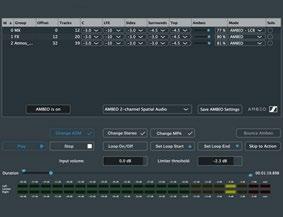
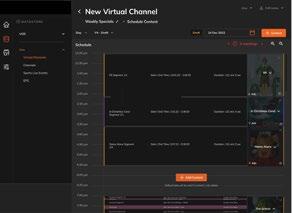
Based on an intuitive node-based designer and On-Hertz’s comprehensive web API allowing control over every engine property (design, settings, presets, monitoring...), Artisto brings unmatched flexibility to broadcast architects and operators. Existing capabilities include routing, mixing and comprehensive audio processing. Artisto also natively integrates features usually found in separate equipment or software, such as SIP for AoIP calls/transmission, webRTC, NDI support, (automatic) loudness levelling, multiband levelling/limiting, level detection, audio playout, recording, and more.
Ross Video
Ross Ultrix FR12 Software
Defined Routing System
The award-winning Ross Ultrix just got bigger, smarter and more powerful. Ultrix FR12 features a 12RU modular chassis that is capable of switching audio and video signals from 16x16 to 288x288 with data-rates of 270Mbps up to 12bps. The compact, hyperconverged, FR12 combines audio and video routing, processing, multiviewers, production switchers, and audio mixers into one seamless platform. Enhanced features added through software licensing extends the life of the product and your investment, and reduces the overall cost of ownership, while adding flexibility. SDI coax, Fiber, SMPTE 2110, and MADI interfaces ensure that FR12 can be used in a range of environments.

Sencore Centra Gateway

Sencore - a leading broadcast equipment supplier and developer - submit for consideration their new Centra Gateway; a comprehensive and holistic network orchestration system provided on a ‘Solutions as a Service’ basis. Centra represents an end-to-end, holistic orchestration platform that allows broadcasters to manage the full extent of their media chain, on multiple levels, from a centralized, intuitive interface, located remotely in the cloud or through any on-site COTS hardware or Linux-based PC. Facilitating the reception, transmission and conversion of internet protocols for optimized distribution of video, Centra collects, converts, aggregates, orchestrates and distributes RIST, SRT, Zixi, HLS and MPEG over IP protocols, embracing the ability of these standards to deliver wideo with greater reliability.

Spectra Logic
Spectra Vail Distributed Multi-Cloud Data Management Software
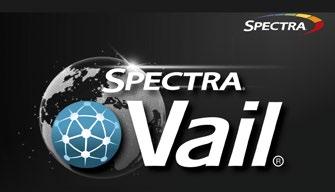
The first of its kind, Vail® is a distributed multi-site, multi-cloud data management software that unifies and simplifies data access, usage and placement across on-premises storage, multiple clouds and storage platforms using a single global namespace, all while integrating public cloud services in a distributed workflow. Vail delivers policy-based data orchestration, streamlining workflows and reducing overall costs and complexities for media and entertainment organizations that want to leverage operation across multiple sites, the cloud, or both.
Quickplay
Personalized FAST Channels
Free, Ad-Supported Television (FAST) has simplified OTT subscribers’ lives by replacing overwhelming options with free streams of content, but until now that has come at the cost of personalization. Quickplay is the 2021 Google Cloud Industry Solution Media & Entertainment Partner of the Year, so its personalization platform leverages Google tools such as BigQuery, Looker and Google Ad Manager to create theme-based channels, personalized content, and enable targeted advertising to maximize monetization opportunities.
The platform identifies viewer preferences and optimal insertion points for ad markers while content and ads are stitched into a single playlist using Unified Streaming’s Unified Remix product.
Rohde & Schwarz Broadcast and Media TH1

If the terrestrial broadcasting market is to have a secure future, it must embrace new opportunities, increase cost-efficiency, and acknowledge and actively engage in the global moves to a lower carbon environment. The TH1, first in a new generation of transmitters from Rohde & Schwarz, is a major step forward in each regard.
Research from Enders Analysis says by 2027 linear viewing will still represent 61% of all video consumed, the equivalent of two to three hours per day. Equally, the amount of data that can best be distributed by a ubiquitous multicast delivery platform is rapidly growing.
That includes 5G Broadcast, which can deliver simultaneous added value content to all attendees at a sports or music event, for example.
Sennheiser
AMBEO 2-Channel
Spatial Audio
Today, more and more streaming content is produced in immersive formats like Dolby Atmos® or MPEG-H Audio. However, the majority of viewers still only experience stereo. Now AMBEO 2-Channel Spatial Audio translates an original immersive mix into two channels of audio that deliver an enhanced spatial experience with no end-user upgrades required. Compatible with any end-user stereo system, AMBEO 2-Channel Spatial Audio is a renderer that creates a twochannel audio experience that is far beyond what standard two-channel systems deliver, thus unleashing immersive audio for a larger audience than ever previously possible.
SUMOLIGHT SUMOMAX
The SUMOMAX offers unmatched lumen output, with a truly homogenized light field, as compared to other LED fixtures in its size and weight class. Its extraordinarily high lumen output is achieved by a careful combination of precise optical arrangements and cutting-edge power technologies within the fixture, based on years of advanced research and development; all completely tested, fully compliant and under SUMOLIGHT’s exclusive patents.
It was designed from a new perspective from the ground up with only SUMOLIGHT’s trademark simple-to-cluster shape, shared by the rest of the family. The new perspective is based on interactive connectivity. SUMOMAX seamlessly fits into the new palette of technology currently deployed in the broadcast and filmmaking industry.

THE IMPORTANCE OF THE SHARED EXPERIENCE
Having already released The Marketing Leaders Power Book earlier in 2022, The Circle Society is now turning its attention to the leaders of the media and entertainment industry. The Leaders Power Book, which is expected to be published in time for NAB, aims to acknowledge achievements within the industry
At IBC, The Circle Society brought Jeff Rosica, CEO and president of Avid, Iatakoo co-founder and president Jade Kurian, and EVS chief executive Serge Van Herck together with DPP CEO Mark Harrison to discuss a number of topics, including current industry challenges, and the move to hybrid working and its impact on innovation. Here, we feature a snapshot of that conversation.
Mark Harrison (MH): What a really interesting time for the three of you to be leading your businesses, which are all different businesses in different ways. If you look back to 2017/18 there was massive change happening in the industry, as we all know, then we had the impact of Covid, and all the things that happened around that both from a technology point of view but also from the point of view of workforces.

I’m really interested to know, do things feel different now from what they did three years ago in terms of your company and what’s important to making it operate successfully?
Jade Kurian (JK): I’m sort of that person who thinks that as much as things change, they stay the same, and that what we’re seeing now is what we’ve always seen, that we have to listen. If you listen both to your employees and the people that you’re servicing, then you’re going to get that feedback loop and you’re going to create and innovate based on that. Yes, culturally, things have shifted, and I think things are going to shift back and forth. Right now we have work from home, where especially bigger companies are able to give people that luxury of working from home. A lot of times I think smaller teams need that face-to-face, they need that time and that shared experience to succeed. What we’ve been doing is offering a hybrid approach. A lot of times, engineers will ask us, should we go all virtual? And we say, no, go hybrid; have some hardware and have some virtual. I don’t think that you can really succeed together as a team without some of those shared experiences.
Jeff Rosica (JR): I would agree. I think hybrid is the way to go for the future. Fundamentally, things have changed. There has always been remote workers; every company I’ve ever worked for, there’s always been a percentage who work from home. From a cultural standpoint, I worried about the fact everybody was remote all the time, and everybody was at home all the time and not really interfacing even with friends for a long time, and not really interfacing with each other as a company. We didn’t have trade shows going on, we weren’t travelling in large numbers to customer events or having events, there wasn’t any shared experience as an employee.

MH: Were you seeing a measureable impact of that within Avid?
JR: I wouldn’t say that we have the data to say that efficiency is down. In my gut, I know that you won’t innovate as fast. There’s valuable time in people sitting around ideaising and there’s valuable time in how people collaborate together. There’s a real value in people being together and keeping that culture. At Avid we’re lucky because we have a culture where people just love this industry and they love being a part of ‘team Avid’, but also because they built these shared experiences, they built relationships over many, many years. That only lasts for so long; new employees come in, they don’t have that same experience. We have to find a balance and whatever that new normal is going to be; as Jade said, it won’t be fully remote for everybody, it won’t be fully in the office again. I don’t think it should. None of us wants to spend a bunch of money on real estate costs. It’s going to be a different world. But I do worry about innovation, collaboration, these things need some nurturing.
MH: Serge, I have a feeling you might agree with that?
Serge Van Herck (SVH): When Covid started in March 2020, we sat down to discuss our objectives and strategy to make sure that everybody had the same ambition going forward. Covid was an interesting situation for us, because suddenly, we all had to start working from home. EVS
has our headquarters in Belgium and 25 offices around the world, and at that moment in time, our link with all our colleagues worldwide improved because now we were all working from home and had that same experience as a home office or remote offices. We learned a lot and we kept that way of working. We feel that we have much more interaction with our colleagues with kept that flexibility. It’s also one of the expectations that new team members have, the flexibility of working from home or the office.
JR: The technology isn’t expensive. We have Zoom rooms at our headquarters, our offices have really cool technology, and we’ve invested a lot more time in that. It’s a fraction of what we spend on real estate. I agree with what Serge said; definitely you’ve got to have more flexibility in this place we’re in and the environment we’re in. I was in the office from the very beginning, I actually only left for about a month and was back in because we had all of our hardware engineers come back because of the labs and test labs, they were all back in right away, and I didn’t want them coming in if I wasn’t willing to come in. What I noticed is that as we started opening back up, it was the young people who came back. The longer-timers were not the ones going back to the office, it actually was the young people because they wanted to share the experience, also they want to learn from each other, they want to learn from other people. We’re hearing from some of the younger people that they’re disappointed more of the long-timers aren’t coming back more days because they want to learn from them. It’s hard to do that on Zoom.
MH: Are you so confident that you will stay in hybrid for a long time that you’re actually going to give up offices?
SVH: It’s not our plan at this moment in time. We built a beautiful new headquarters in 2016. It’s on our balance sheet. We’ve built it, it’s not going to go away. We have offices around the world. We have no massive objective to reduce any spaces. When we acquired Axon in May 2020, we had two offices in the UK and we brought them together, and in a much nicer environment than what they both had before, so there was some rationale behind that. But there’s no structural effort or objective to reduce space.
JK: I would say that all of our customers that we have recently met with in person have just been relieved to see people and they keep saying, ‘it’s so nice to see you in person!’ Building that relationship is so much easier in person than on Zoom or on some virtual method. If you’re trying to sell, you get nearer to the close by being there in person, because they can look you in the eye, they get to see you and they can determine whether or not they trust you.
MH: At the DPP we’ve observed that if you go back to 2017/18, there were quite a lot of end users standing up on stages at various kinds of conferences almost wagging their finger at the vendor community saying, ‘you’ve got to catch up with us’. It feels to me as if that’s changed, partly because of the shared trauma of Covid, where everybody needed each other more, but also because change has been going on for long enough now that actually everyone’s worked out this isn’t necessarily simple. It’s not a matter of some vendor having perfect requirements for you, there’s more to it than that.
JR: I would say that there is more of a shared relationship between broadcasters and vendors with trying to figure out how we’re going to innovate, what we need to do to help this industry move forward and be successful. It’s become even more collaborative, and there’s more empathy and understanding on both sides. One thing I will say is that I’ve never seen anything like this. I’ve never seen so many changes, technological shifts, business shifts happening, demands changing, business pressures changing. If we went back in time and looked at any time in this industry, there’s never been the pure scale. It feels like it’s five times what it’s ever been that we’re dealing with at one time. That is going to require listening, talking, understanding, prioritising. What this industry is going to have to do is prioritise better. We know there’s lots to do, but we can’t do it all. There’s phenomenal opportunity out there in how we can innovate for people to help their business and help their operations and what they’re trying to do. But I think there is a better collaborative work to that dynamic.
SVH: Thinking back to 2020 and the start of the pandemic, we had broadcast customers who suddenly had to go from everybody in the studio to nearly everybody at home. We had to do a massive amount of work with our customers to do that shift. It really brought us closer to getting to that moment in time to help them migrate to remote production and teach them how to use our tools to do that. At that moment in time, it helped us to even have closer links with those customers, and we have continued to have that.
MH: What is the thing that you feel that as an industry we should most focus on right now if we’re going to keep up with the speed of change, and if we’re going to make these new, better, relationships more fruitful?
SVH: For us, clearly ESG; that’s something that we need to improve. Last year we did our first report on sustainability. That is definitely something that we as a company, we as an industry, have to further work on, and make sure that it’s more than just marketing, that it’s a reality. In terms of the young talent that we attract, they are very, very conscious of that.

For us who are a bit older, it’s something we still have to fully embrace. But we’re working on that.
JK: I think for us, it’s the proliferation of credible information. That’s what we’re interested in and it’s what we focus on. We want journalists to do real stories, and put credible information out there. What we have today – disintegration of governments and all kinds of societal wants and needs – a lot of it can be attributed to the lack of credible information. People are listening to their neighbours who are probably not scientists, technologists or engineers. I think what journalists do is go out there every single day, and become an expert in something that they were not yesterday, and they try really hard to tell the whole story. That’s what we want to do. We want to support those people who are doing that, because there’s too much of ‘I’ve heard this from my neighbour on Facebook and so it’s true’. It’s impacting not only our governments but our culture, and it’s impacting business as well because you’ll hear team members talking and they’ll say, ‘I heard on Facebook’, and it’s not true.
JR: What we’ve got to try to figure out as an industry pretty quickly... I used to like the term ‘remote work’, but really it’s ‘distributed teams’. If we look at the amount of content required in these models we’re all moving to as an industry, moving from linear advertising models to streaming, whether it’s a local content provider in any given country or the big, international ones like Netflix, they all need to crank up their content machines. We’re not going to have enough people, we’re not going to have enough resources to do all they want to do. So I think we’re going to have to figure out how to enable people to really work with anybody, anywhere, on anything, and also be able to do that efficiently. We’ve got to figure out how we do that because our industry needs it, or it’s going struggle in a few years. n
Nominations for The Circle Society’s Leaders Power Book are now open. Find out more at https://thecirclesociety.net/leaders-powerbook-applications-now-open/
SUCCESSION
Having spent the past six years working with TSL on a project basis, Matthew Quade has now joined the company full-time in the role of CEO. He takes over from managing director Chris Exelby, who has been appointed executive chairman of TSL’s board of directors.
Originally, Exelby approached Quade at the end of 2021 to ask for his help in finding the company’s next CEO. “He was looking at retiring and asked if I would help in supporting the transition and finding the next person to lead the company,” Quade explains. “I was more than happy to do that.”
Discussions then moved on to whether Quade would be interested in taking on the role on an interim basis while the search continued. “I sat back and thought to myself, I’ve been doing this for a while now. I know the people, I really like the team. I love the industry and the products. Why would I only do it on an interim basis? So I approached the board and the shareholders and said I’d be interested in putting my hat in the ring and we went through a full process.”
After securing the role, Quade and Exelby spent six months in a period of transition, enabling the new CEO to learn more about the parts of the business he hadn’t previously been involved in. “The great thing for me was I got to actually design that process as well,” Quade adds. “It meant I was ready to go on day one, rather than having to learn and pick things up.
“It’s been fantastic to work with Chris through that period, manage that transition together and get the team used to the idea that I’m ready for that as well. I had existing relationships with a lot of the team, but clearly, when you step into the role of CEO those relationships change a little bit. So getting people used to that and adapting to that has been very helpful.”
Asked what drove his decision to work with TSL on a permanent basis, Quade says it was a combination of a great team, both at a leadership level and throughout the organisation, and a great set of products. “The company has a strong brand presence and operates in a number of exciting markets,” he continues. “Looking at an opportunity like that, that has those building blocks already in place, it’s somewhere I know I can use my diverse experience to really add value and help take that business to the next level.
“A lot of the time when I have worked with businesses there are specific things that I’m going to fix or a one-off project, whereas with TSL there wasn’t necessarily anything to fix. There’s a great platform there, and so the opportunity to actually go in and build on that platform and take it to the next level was just too good not to go for.”
OPPORTUNITIES FOR GROWTH
It’s that possibility for growth across multiple industries that Quade believes will drive TSL forward. He adds that he sees TSL as a technology company with a specialism in media. “TSL has developed primarily in the broadcast and media sectors and that sector has been a proving ground for its technology, which has been great because I think that sector often has higher expectations in terms of quality, and in terms of the features and spec it needs,” he says. “That is a great starting point because if you’re successful in that industry, you can be confident that you can be successful with it elsewhere.”
Quade believes there are also opportunities for the company in social media, pro AV, houses of worship, esports and corporate services, adding that media, in its broadcast sense, is used by every business now. “If you operate and you provide media solutions there’s almost nowhere that you can’t look to target,” he states. “I think probably one of TSL’s USPs within the media sector is the way in which we’re very happy to work with a wide range of other vendors and even with competing vendors and products. The flexibility that we can offer there is something that means our customers don’t have to get tied to one or two tier-one vendors. They can really choose the best in class for them from a wide range of products, and we can act as the glue that binds all that together. That gives us a unique position within broadcast and media.”
Like many who work in the media technology industry, Quade admits that people he meets have no idea how the content they watch actually ends up on their screen. “Of the companies I’ve worked with or for over the years, the most interesting ones are always where you learn exactly how something works that you use every day without even thinking about it. So I think from a personal level, that’s the fundamental reason why the technology in this industry is exciting.”
THE CLOUD
One such piece of technology that is having a huge impact on the media industry is cloud. Pre-pandemic, many broadcasters would say it was something that they were aspiring to. Post-pandemic it’s become critical. However, Quade is keen to stress that when the industry talks about cloud, it’s actually talking about virtualisation. “I think people love to talk about ‘the cloud’ as a vague term, but really it’s about the move from solutions that are provided with hardware that’s in a fixed location, to solutions that are provided by software that can be distributed across multiple locations and used from anywhere,” he
Announced just before IBC, Matthew Quade has been appointed as the new CEO of TSL. He sits down with Jenny Priestley to discuss why he chose to join the company full-time, his vision for TSL, and the impact of the cloud on the media industry
says. “Even before Covid came along, TSL was providing lots of remote production and virtual solutions to its customers that enabled them to be able to either monitor or control hardware products from a range of different places.”

Key to convincing the industry that cloud is the way forward is familiarity, particularly for the end user says Quade. “Engineers are used to holding or touching a physical product and turning knobs and pushing buttons,” he says, “and when you’re trying to move them to something that moves around with them and doesn’t have those buttons, you need to give them as much familiarity as possible.
“Very soon after Covid hit, we were able to develop and deploy on webpages, virtualised web-key button representations of our physical control panels that were back at an installation. That meant an engineer working in their own bedroom with a VPN connection could run up a webpage that looks just like the physical panel they were used to sitting next to, the buttons look exactly the same, and they could view what the panel is showing in real time. Now they’ve had the experience of that working, they know if they want to sit at home one day and do it from their computer screen they can.”
Quade adds that there will be a part of the industry that always produces hardware because without it, the cloud doesn’t exist. “There’s
always going to be that element, but the hardware will become functional black boxes that just sit in a rack somewhere distant from the user,” he states.
However, while much development of hardware at the moment is pretty much on pause across the industry due to the issue around component availability, TSL is continuing with developments across all three of its core product areas. “We were looking very closely at sustainability until about a year to 18 months ago,” explains Quade, “but that is on a little bit of a pause in terms of how we actually manufacture the hardware products because in reality now, you need to use the components that are available in the market. Certainly, in terms of new product design, it’s always a feature when considering the materials to use and the sustainability of sources of those materials.”
He adds: “At TSL probably one of the leading technologies that we have that can support customers with sustainability is our Insite product in terms of monitoring power outputs and distribution, and our new range of power distribution units themselves, particularly the intelligent PDUs that are shortly going into production. Together they enable users to monitor and control rack-mounted equipment anywhere in the world and manage power requirements and therefore, materially reduce the amount of power that goes to waste and of course the corresponding costs.” n
BLURRING THE LINES BETWEEN VENDORS AND CUSTOMERS
In the latest as-a-service offering, MediaKind and Arqiva have joined forces to offer broadcasters and video service providers a new hybrid content processing service that they hope will transform headend services.

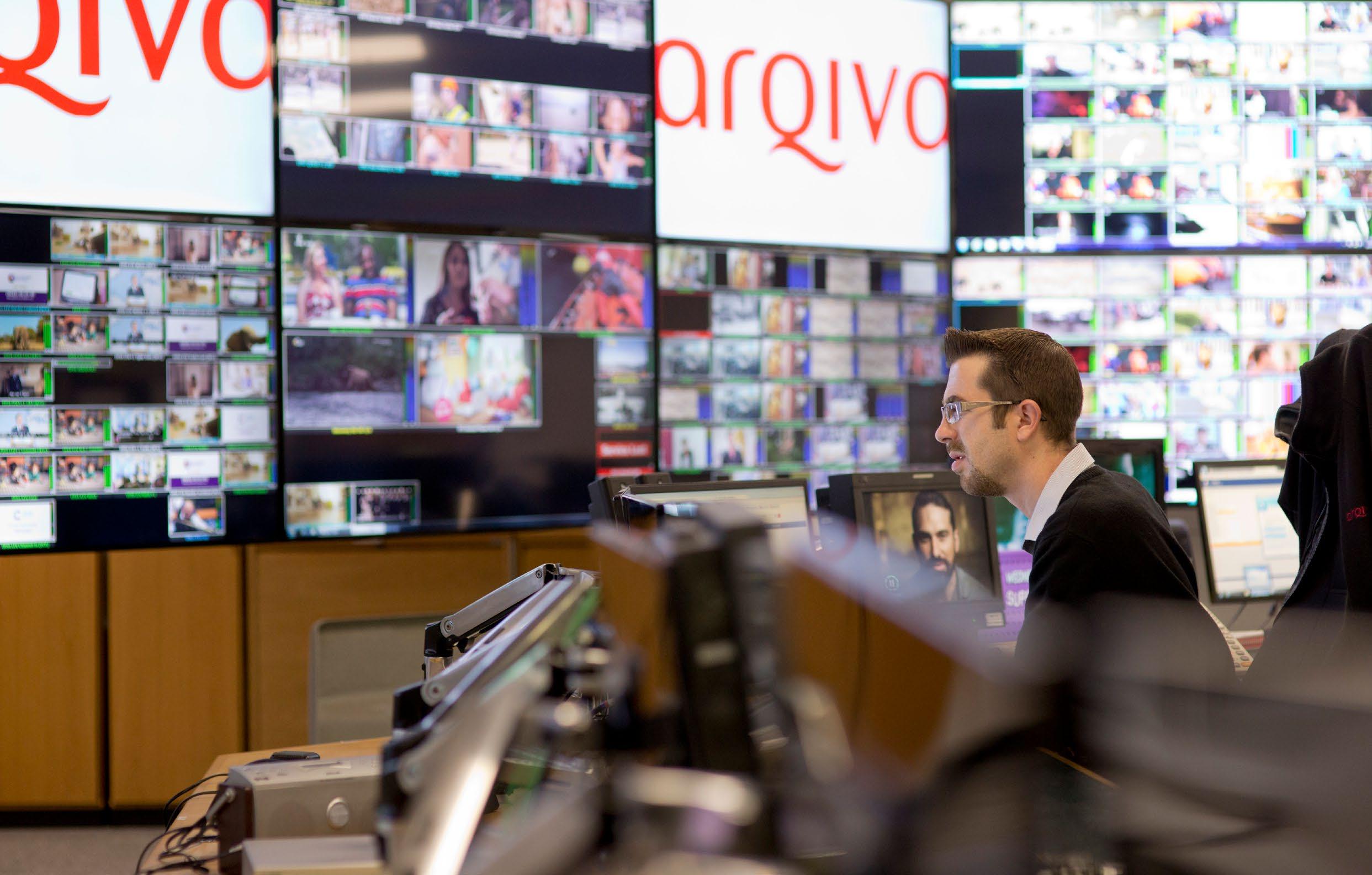
The two companies first announced plans to work together on a cloud-migration managed service at the end of 2021, and the debut of Arqplex service at this year’s IBC was the culmination of that project.
They say Arqplex will unify OTT and broadcast operations, reducing complexity, increasing efficiency and delivering rapid speed to market for customers. It combines MediaKind’s cloud-native multiplexing, encoding, and packaging headend media processing technology with Arqiva’s expertise in managed services, systems integration and connectivity. Arqiva’s operational teams will fully manage and monitor the service, delivering real economies of scale to headend operations.
Although officially launched at IBC, Arqplex is already in use via Arqiva’s private cloud, reveals the company’s director of product, Matthew Huntington. “There are 30 or so Sky-based TV channels that are already using it,” he explains. “They don’t choose how we multiplex their services, that’s our choice, and so we’re using Arqplex. The first customer who does choose the platforms they use will
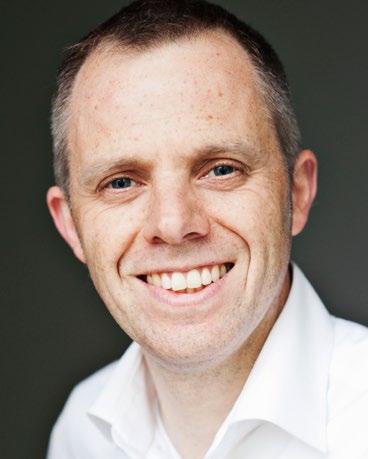
MediaKind and Arqiva have partnered on Arqplex, a hybrid content processing service designed and developed for a broad range of broadcasters and network or platform operators. Jenny Priestley finds out more
go live later this year. We signed another deal just prior to IBC and they will launch next year,” he teases.
For MediaKind’s head of portfolio development Carl Furgusson, Arqplex is the next step in the companies’ relationship. “MediaKind and Arqiva have had a longterm relationship as a vendor and a managed service provider,” he states. “As we’ve been working together we started to see the transformation to cloud technologies reshape the nature of this relationship into much more of a partnership, where both of us have got skin in the game to actually make sure that all of these services remain up to date, secure, reliable, and on air.
“At the core you have MediaKind technology for broadcast and for streaming, we maintain a workflow from the point that content hits the cloud until the point that it is ready to leave again,” he continues. “We maintain that for all the three major clouds, we follow all of the changes with all of the virtualisation software, all of the open source, all the security patches, all of the changes that the cloud providers are making to their infrastructure pieces, whether it be load balancers, or NAT gateways. We continually test and update the solution, and we also lifecycle-maintain that as well.”
One of the key benefits of the partnership, adds Furgusson, is that MediaKind has taken over 24/7
monitoring of the solution and its infrastructure for Arqiva. “It’s kind of blurred the lines to some degree between what has historically been a traditional vendor/user relationship into the two companies working together more efficiently, more sensibly, leveraging the skills of MediaKind where they’re most appropriate in terms of maintaining the infrastructure while using the renowned skills and services that Arqiva provides, with all of that connectivity and security around it as well,” he says.
For Arqiva, the partnership means that it can offer its headend services globally and therefore grow the business. “We provide managed headend services for a range of customers, both internationally and in the UK, including Multichoice, South Africa,” explains Huntington. “What we want to do is take that capability that we’ve developed and really scale that up so we can offer those services globally. We can do that with our own private cloud, but by using public cloud we can really extend that service on a global scale.”
That enables Arqiva to offer its customers a much greater economy of scale, he adds, so that as they’re coming under pressure from changing consumer viewing habits and competition, they can be more cost-efficient. “They also need to be more flexible,” Huntington continues, “so we need solutions that allow them to experiment, to spin up new services and take them down again, without having to make big capex investments, and they need to make sure their operations are as efficient as possible. Providing that as a managed service means we can deliver on all of those things.
“It’s also about combining OTT and broadcast operations together, within a single platform, a single operational set of processes, so there are efficiencies to be gained there,” Huntington says. “But there’s also the need that as OTT becomes more important for service providers and broadcasters, the service level around it is increased. If you talk to a lot of operators today, they’re running their OTT operations at a lower grade of service than their broadcast operations. That’s really looking back to the history of when the OTT services weren’t that critical and strategic to what the broadcasters were doing. Now they have become strategic and broadcasters need to upgrade their monitoring and management.”
Asked which company approached the other about furthering their partnership, Furgusson says it was more of a joint evolution driven by Arqiva’s move towards private data centre virtualisation. “It kind of organically evolved,” he explains. “We both collectively saw that there were various opportunities externally in the market that either one of us could address. You have the customer base, who have always naturally approached Arqiva as that renowned managed service provider, and at the same time, you have MediaKind customer relationships, where we’ve traditionally sold products to broadcasters, service providers and pay-TV operators to then use themselves.
“We see an opportunity where the customers that we would normally sell to directly will need more of a migration, or even a hybrid approach, of using a managed service provider for part of their services, while still operating other parts of the services themselves.” n

HOW TO SUCCEED AT MULTIPLATFORM PLAYOUT
By David Thompson, chief product officer, Veset
As an increasing number of ways to consume media have emerged over the last decade, consumers have become accustomed to having a seemingly unlimited selection of channels and platforms to choose from. This rapid industry expansion has created what some are describing as an over-saturated market. Delivering a channel to one destination is rarely still an option to gain an acceptable audience share.
While it is clear that multiplatform playout is important, it still comes with a number of unique challenges.
COMPLEXITIES OF MULTIPLATFORM PLAYOUT
Each of the many platforms out there has its own technical requirements when it comes to things like video stream formats and EPG metadata. If the playout system is unable to deliver to the specifications needed by a particular platform, then multiple playout systems are required.
This is problematic for several reasons. If there is a need to change something on the channel such as scheduling, graphics or announcements, the change needs to be actioned across all of the different variants. In addition, running multiple versions of the same channel across different playout systems makes it more difficult to react swiftly to changing analytics, and as we all know, audience share and revenue are vital when it comes to adapting and evolving the service.
When managing playout to multiple platforms, broadcasters have to simultaneously juggle the technical complexities of playout to each individual platform. It is also increasingly important that broadcasters act quickly, while interest is high and audiences are receptive.
MAXIMISING THE CHANCE OF SUCCESS
The cloud is making playout to multiple platforms much simpler than has been possible previously. However, it is not enough to simply move to cloud playout if you are not maximising the flexibility, scalability, and efficiencies that it brings. It is also true that not all clouds are created equal so there are a number of important considerations to ensure you maximise the chance of success across platforms:
1. Understand and meet differing technical requirements
Cloud in itself won’t mean you can distribute to multiple platforms with ease. You will need the right intelligent management tools to ensure your system knows which platform the content is being pushed to and the unique technical requirements for each of those. Ensuring your channel is always delivered to the right platform with the right format will ensure
a smooth and seamless viewing experience and keep viewers happy no matter where they are watching.
2. Enable cross-platform analytics Analytics around user engagement and behaviour are critical for any service. Being able to compare and consolidate these across multiple platforms can be complex, but data is critical to any channel’s success. Having a unified way to do this across the different platforms will make it much easier to analyse that data. Ultimately this should lead to continual adaptation and improvement to better meet consumer preferences.
3. Ensure you can expand to new platforms quickly Analytics should be used to adapt and expand your channel. Once you understand where your potential audience is watching, you will want to get your channel available on that platform quickly. This is where cloud really comes into its own, making it faster than ever before to add new platforms, but it needs that overarching management to make sure that all the requirements will be met and to ensure viewers get the same level of user experience, no matter where they are watching.
4. Diversify and experiment Cloud playout not only makes it quick and efficient to launch new channels and expand to new platforms, but also to scale down distribution when audiences may not meet commercial expectations. This means that it is easier than ever to experiment. Content providers can afford to launch a channel, and if it fails, close it down and try the next one. This in turn leads to much more variety for consumers and makes it feasible to launch more niche channels.
DIRECTION OF TRAVEL IS CLEAR
In general, it’s clear that the industry is moving towards a more cloudbased future. It is little wonder that playout also seems to be following in the same direction, given the numerous benefits that cloud can offer. At a time when competition in the industry is like never before, broadcasters need to leverage every tool available to help their operation to thrive. This includes reaching new audiences, and increasing engagement through expansion on to multiple platforms. With so many channel operators opting for cloud playout because of the high levels of scalability and flexibility it provides, broadcasters who choose to retain hardware-based playout tools risk getting left behind. n

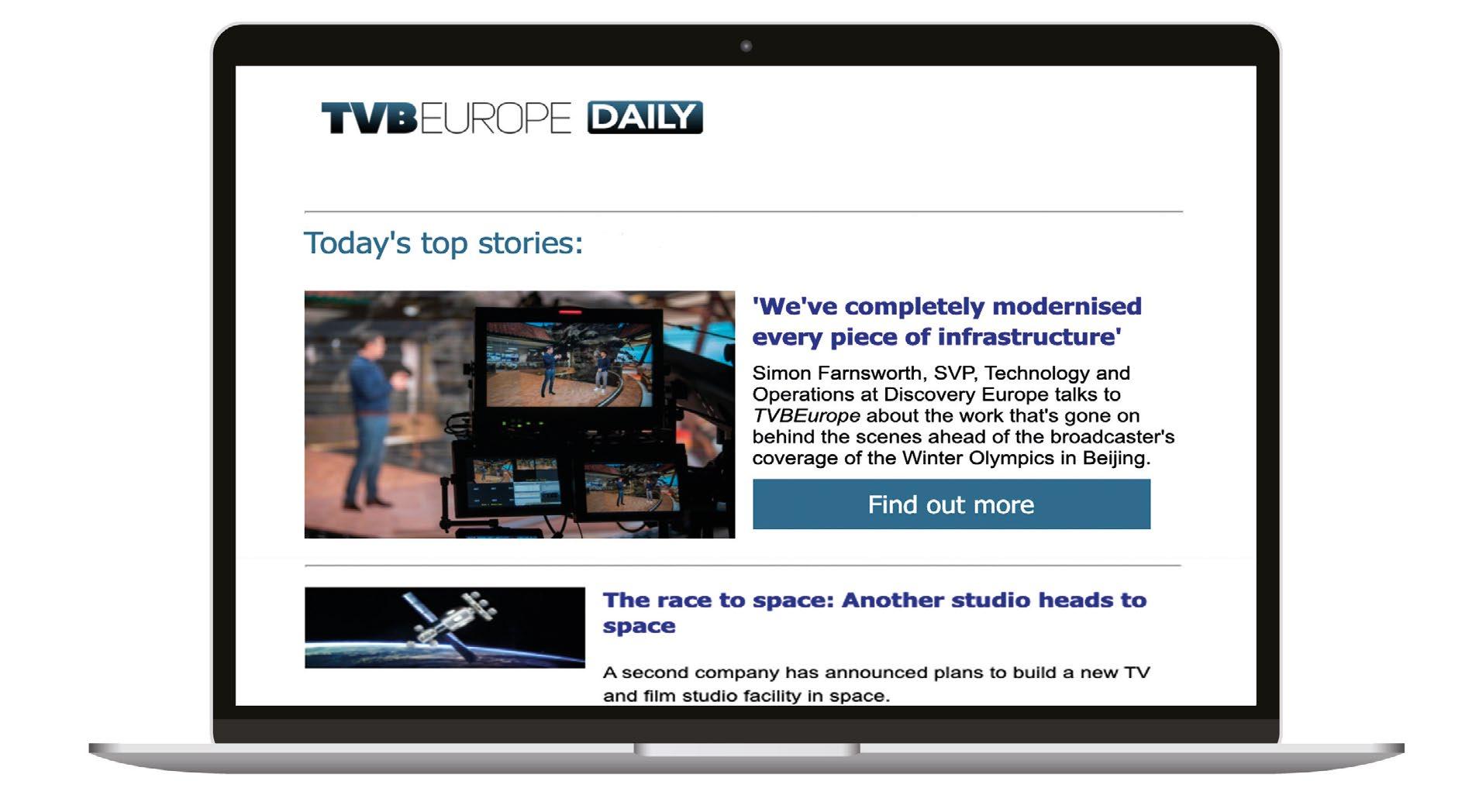

AN EYE ON THE FUTURE
During IBC, Avid CEO Jeff Rosica sat down with Jenny Priestley to discuss the return to trade shows, the industry’s move to the cloud and what that means for the company, and why encouraging the next generation of talent is so important

One of the biggest announcements pre-IBC was the news that Avid would have a stand at the show after all. Back in February, the company had said it would not be exhibiting at either NAB or IBC due to the pandemic, but that decision was reversed during the summer as the impact of Covid began to wane. And it certainly paid off, with Avid’s slightly smaller-than-usual stand as busy as ever. “We decided to come back, and I’m happy that we did,” Avid president and CEO Jeff Rosica says. “I think IBC from our standpoint has been very successful. The traffic was good, the booth was busy the whole time. We’re very happy about how IBC has turned out.”
Asked if that means Avid is planning to be back at trade shows full-time in 2023, Rosica says that the company has learnt a lot during the pandemic, including that many of its customers like other forms of interaction. “We learned that our customers want other types of marketing, they want virtual events, they want face-to-face events,” he explains. “We’ve been doing more one-on-ones with customers, we built a new customer experience centre at our headquarters, so our mix has shifted. Major trade shows are going to be part of our mix going forward, but they will be different. You’ll probably see us invest a little bit less in major trade shows because we’ve invested more in other areas, but they will be part of our future.”
Back to this year’s show, and Rosica says the key theme from clients at IBC is ‘we’re getting back to normal, whatever normal is’. But, there are some key priorities for the industry as we move forward. “It’s all based on the transformation of their business,” he adds. “Obviously, business models are changing, that’s having a lot of impact on operational requirements and technology needs that they have. Everyone’s just trying to figure out how to create high-quality content and do it more efficiently. It’s not just cost, it’s also labour availability.”
Rosica continues: “There are so many things constraining the ability to create the level of content they want, so they’re looking for technology to help strategically answer some of these things that they’re doing. But it is all about efficiently creating more content, faster. Cloud is obviously a big part of that. Cloud isn’t about just lifting and shifting things from on-premises to a public cloud. It’s about innovation. It’s about changing workloads, changing the way businesses operate, transforming the way things are done. If you’re not doing that, you shouldn’t be going to the cloud.”
Avid hasn’t been backwards in moving forwards with the cloud. Rosica himself announced the “next generation” of the company’s MediaCentral platform at IBC 2017. Five years later, how does he view the role of the cloud as the industry continues adoption? “I can’t speak for every
vendor, but if you look ahead two, three years from now, I think we will be very mature and pretty sophisticated as an industry around cloud deployments, and technologies enabled by cloud are going to come forward,” he says. “We’re already making very good progress in 2022. If I look ahead at the innovation, what will be going on in 2023/24, I think we’re going to see continuous progress towards a new vision of how our industry buys and deploys technology.”
Asked where Avid fits into that new vision, Rosica states that he hopes the company “fits right into the centre! Joking aside, Avid has already made a lot of progress in the cloud,” he continues. “We’ve done a lot of work with Disney, Marvel, and Paramount. Recently we made an announcement about Amazon Studios building their studio in the cloud and as they said, Avid is the centrepiece of that strategy. I think we’re already pretty far along, and there’s other work we’re doing that we haven’t gone public on.”
Another topic close to Rosica’s heart is encouraging the next generation of the media tech industry that this is the place for them. Again, this is an area where Avid has been front and centre in terms of making its technology available to those who aren’t yet working in the industry in order to help them to gain experience in using its solutions. “We have to make the tools really accessible and available to people, and that means they can get to them inexpensively and without having to jump through hoops to be able to get access to them,” he stresses. “We need to continue to develop learning tools that help people. How I learned to use tools in the media space is not the same way people today are learning tools. They
want more snackable content, they want smaller, bite-size ways of learning these tools.”
It’s equally important to raise awareness of the jobs that are available in the industry, something that TVBEurope has been doing with our online Meet the… feature. Rosica believes that as an industry, we need to make those roles more accessible and offer more training. “Not everyone can afford the most expensive higher education at a film school or journalism school. We need to do more to get those programmes into education earlier. Not everyone even goes into higher education. How do we do more for people to learn the jobs and learn the tasks so that they can be employed?” he ponders.
“I think it’s critical for our industry. If you look at the rate of commitments that the big streaming providers have for content creation in the next few years, we’re getting to a dangerous collision point where we’re not going to have enough people to get the work done,” Rosica continues. “We’ve got to get out to the next generation creators, and that means we’ve got to open our eyes and minds, making sure we’re getting to people all around the world, we’re getting to more women in this space, people of colour, people from different backgrounds. We’re going to have to go wider than we typically have. We can’t just keep hiring in London, Los Angeles, and New York.
“That talent can be anywhere in the world, and they can get jobs anywhere in the world, because people can work remotely, people can work in new ways. I think that really opens up a lot of possibilities.” n
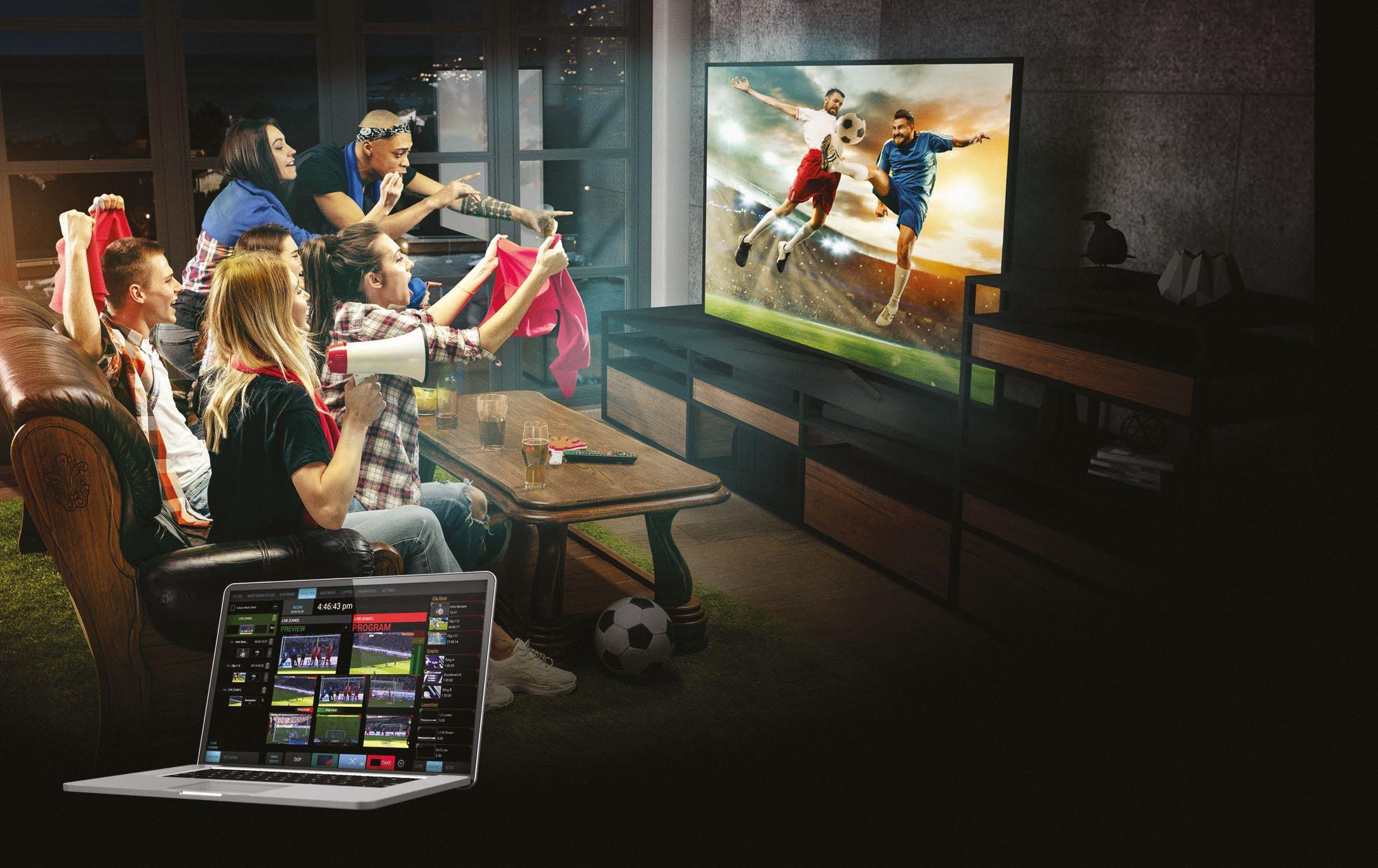
PRODUCTION AND
BROMPTON RIDES INTO ITS NEXT DECADE ON THE VIRTUAL PRODUCTION WAVE
LED is now well established as a replacement for green screen in broadcasting. Video processing specialist Brompton Technology has experienced the rise of this market in its first ten years, as chief executive Richard Mead tells Kevin Hilton
In the last ten years, LED and virtual production technologies have made serious inroads into the broadcast market, changing not just how TV programmes look but also how they are made.

Companies supplying systems for this still relatively recent way of programme making range from established names to operations that launched straight into the new field. Among those in the second category is Brompton Technology, which has been celebrating its tenth anniversary this year.
Brompton Technology was established by product development and manufacturing company Carallon in 2012 to produce LED video processing products. Carallon itself was founded in 2004 by seven engineers who had worked previously at Flying Pig Systems, developer of the Wholehog lighting console range. It was set up to develop control systems for the entertainment industry, working on a contracting basis with leading brands such as ETC and Harman.
When the founders of Carallon started to come up with their own ideas for finished products, they decided these should be marketed under the banner of associated but separate companies. “It would have been confusing to have Carallon as a service provider to other manufacturers and also selling its own products,” explains Richard Mead, originally chief
executive of Carallon and now chief executive at Brompton Technology. “And we recognised that their strategies might well diverge with time.”
The first ‘spin-off’ was Pharos Architectural Controls, which specialises in lighting controllers. This was followed by Brompton Technology and then SixEye, a developer of remote management devices that allow system integrators to manage installations from the cloud. Brompton’s first product was the Tessera M2 LED processor, which has been followed by a full range of processing, distribution and receiver card units.
“From the very beginnings of Tessera LED processing, performance on camera was a priority,” Mead says. “Although live events were our primary market, many major live events are televised; our very first high-profile event was the Academy Awards in January 2013. So we put a lot of time into on-camera performance and have done a lot of work for broadcast.”
What has changed over time, Mead says, is the shift from LED screens as merely an element of a set to now being used to create a virtual background for production. “Previously, green screen would have been used. There are now different challenges because it’s not just about the LED screen looking ‘good’ anymore, it is necessary for the image to look ‘real’. This aligns well with our company approach because our focus in recent years has been on achieving accurate colour rendition and maximising dynamic range.”
The move on from LEDs being video walls behind a presenter to helping create entire virtual sets was already underway pre-2020 but accelerated rapidly during the pandemic. This has reached a point where broadcasters, facilities and producers are now thinking in terms of utilising available technologies to dramatically change how they work, something Brompton has been experiencing first-hand. Mead observes that “virtual production is a term that covers a lot of ground”, with two main approaches to using LED screens as green screen replacements.
“A lot of studio-based television or video production is now using virtual sets that are generated in a 3D engine presented on an LED screen backdrop behind the talent, often with an LED floor below,” he says. “Where the camera’s view extends beyond the LED screen, the virtual set can be extended in computer graphics and this can all now be done in real time.”
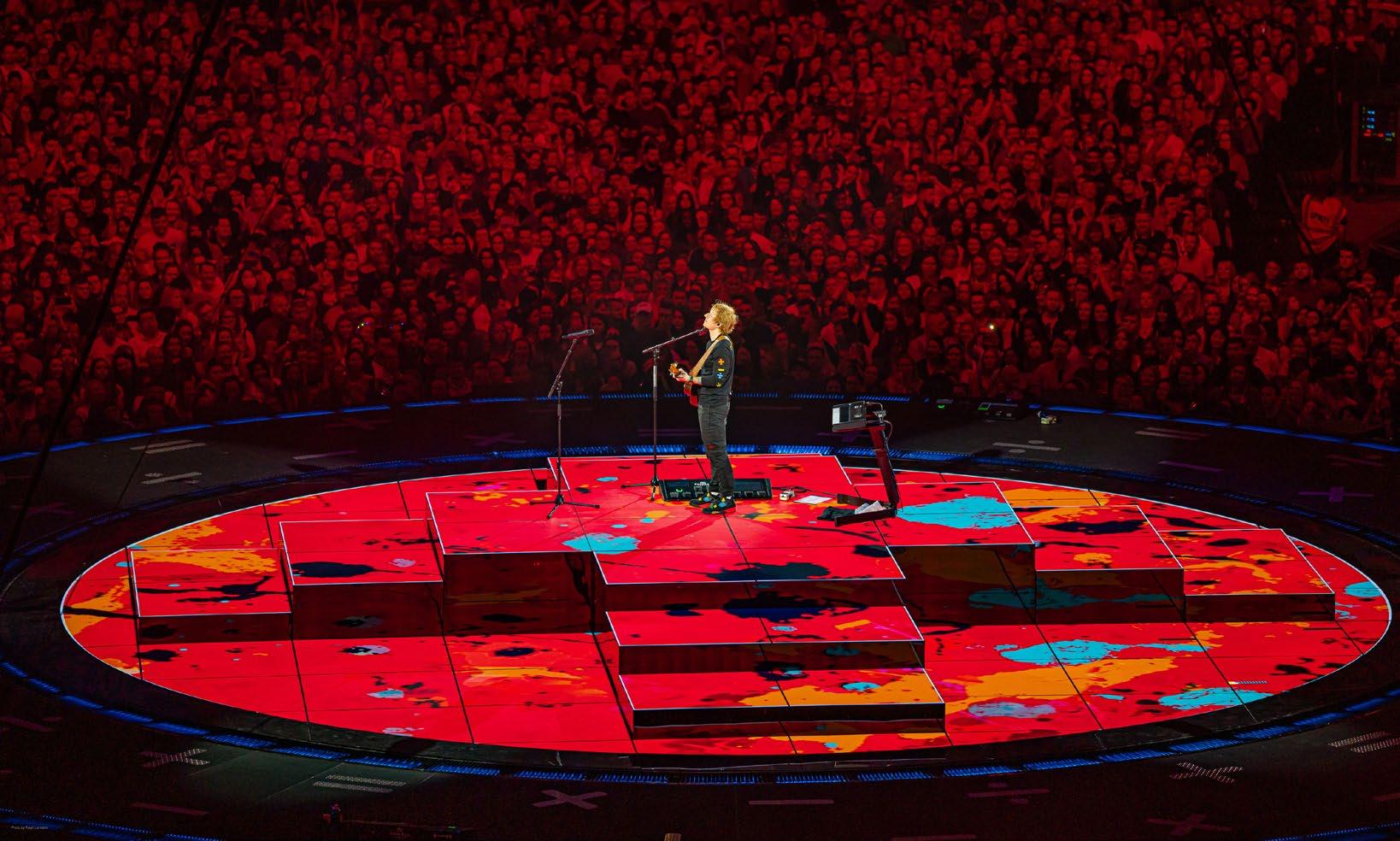
This usually comes under the general heading of extended reality (XR), which Mead points out is about cost-effectively creating a custom set. Sports and news broadcasters have heavily exploited XR in recent years as a means to ‘build’ studio backdrops that feature creative design while also offering an alternative to physical sets and travelling to overseas locations. Brompton systems are being used for such applications, with recent examples including Australian broadcaster Seven Network’s coverage of the Summer Olympics in Tokyo and this year’s Beijing Winter Games. The latter featured LED backdrops supplied by CT Group (part of NEP Live Events) running with two Tessera SX40 processors.
The other application of LED for virtual production is in more filmic work, or in-camera visual effects (ICVFX), where larger LED volumes

add backgrounds ‘in-camera’ through either a generated 3D environment or plates. “The goal is to get as close as possible to ‘final pixel’ with what is shot on camera, though typically there is still work happening in post,” Mead says. “The advantages here are time and cost savings in terms of the amount of visual effects work done in post, plus the big creative benefits of seeing something closer to the final result in-camera.”
Mead adds there is a “fast growing market” for LED in virtual production, with Brompton actively supporting customers working with both techniques. “I won’t claim we anticipated quite how dramatic the growth in demand for green screen replacement using LED was going to be,” he says, “but we had the right technology at the right time to take advantage of the opportunity. Going forward we aim to service our two core markets of live events and film and TV production in parallel. Our recent investment is about scaling up to ensure we do that well.”
The latest move in the financial growth of the company, announced in July this year, was a £5.1 million investment from Connection Capital. Mead said at the time it was necessary to “scale up rapidly” to meet the increase in demand for its LED processors. Securing investment in this way also illustrates the divergence in business strategies between Brompton and Carallon, which became an employee-owned concern in 2020.
“Brompton has gone the route of private equity to allow it to accelerate its ambitious growth plans,” Mead explains. “It continues to use Carallon as a supplier and greatly values the expertise it brings. But they are entirely separate companies that happen to share a common heritage.”
Brompton Technology has carved out its own identity and market over its first ten years and, as virtual production continues to expand throughout broadcasting, that will doubtless continue into its second decade. n
KICKING OFF THE DUTCH FOOTBALL SEASON ON TIKTOK
The Johan Cruijff Schaal has a special meaning for Dutch football fans, not least because the trophy is named after the Netherlands’ greatest ever football player. The season opener, played between the winners of the Dutch Eredivisie and the KNVB Cup, kicks the new season off in style and this year, ESPN Netherlands broke new ground by streaming the match live on TikTok.
ESPN seized the opportunity to explore the webbased graphics platform, Singular.live, through its graphics partner, Reality Check Solutions (RCS), who designed a graphics package purpose-built for social media platform TikTok.
Using Singular enabled ESPN to manage its whole graphics production without any friction with existing SDI video workflows. Singular’s Adaptive Overlays also made it easy for the RCS team to create a custom 9:16 format for the graphics.
RCS created a bespoke, adaptive composition for streaming on TikTok in 9:16 as well as providing a web-based control interface that allowed ESPN to easily add branded overlays without the expense or challenge of requiring dedicated hardware and operators on-site.
THE BENEFITS OF A LONG-TERM PARTNERSHIP
RCS has worked with ESPN in the Netherlands since it first developed an ambitious remote graphics operation for live Eredivisie production almost a decade ago; one of the first of its kind.
Since then RCS has managed the broadcaster’s requested switch from Vizrt to Ross XPression and the relationship has grown to include projects across multiple sports, and innovations such as HDR.
The Johan Cruijff Schaal was the first time RCS delivered a graphics package and workflow using its expertise in Singular for ESPN.
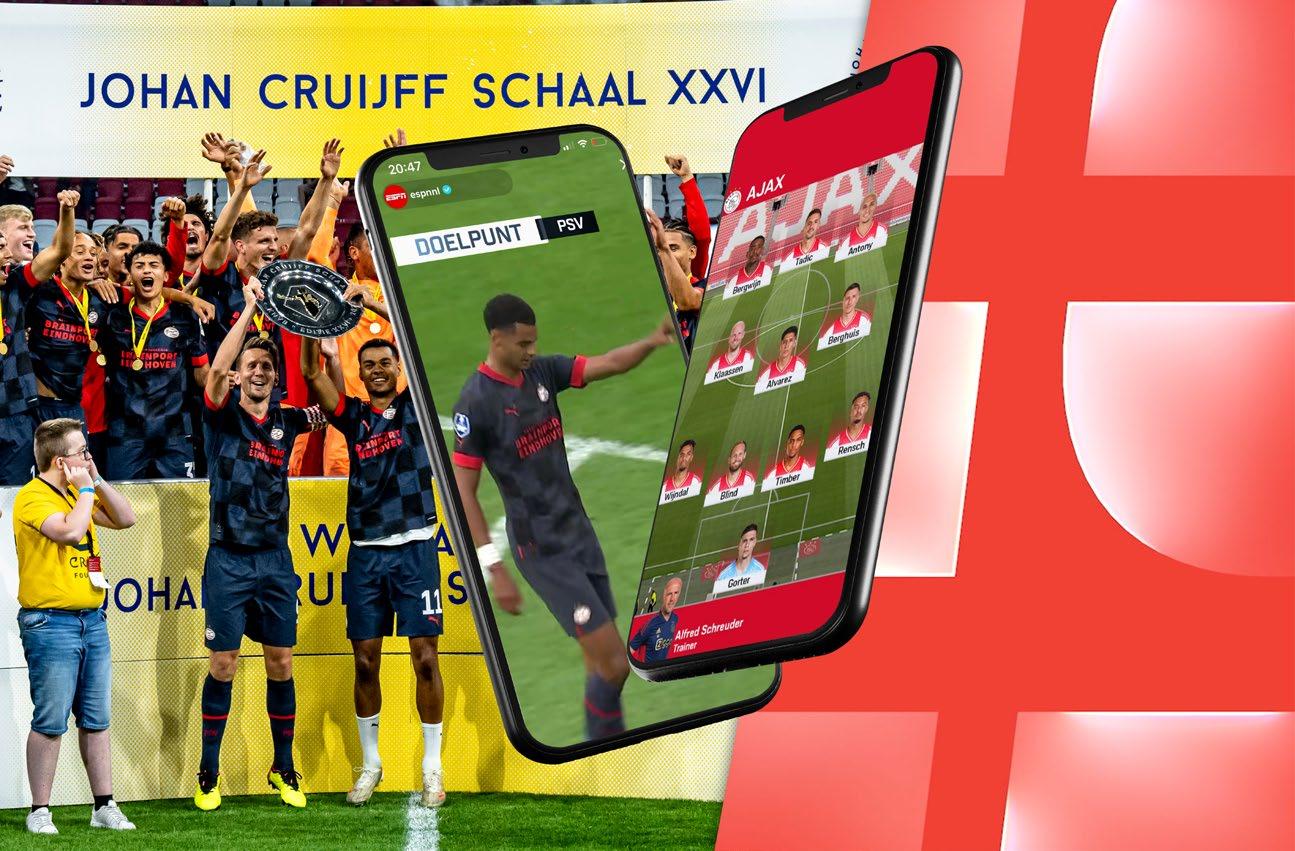
“RCS was historically known for its expertise in Vizrt but we are now adept at delivering solutions across myriad platforms,” explains David Peacock, who led the project for RCS. “We partner with innovative clients who come to us with confidence we can deliver the perfect solution for each project, whatever the technical challenges. ESPN listens to our ideas and demands the highest quality results. Thanks to
our long-term relationship there is a level of understanding and trust that creates a highly effective working relationship.”
SINGULAR FACTOR
Providing a high-quality live graphics workflow that is entirely webbased and requires no dedicated hardware, Singular offers an easy way for clients to quickly add new productions without significant capital expenditure or headcount. It also fits seamlessly into existing workflows and adds remote capabilities natively. As the only live graphics platform accredited for sustainability by BAFTA’s albert consortium, it can also be a significant factor in helping broadcasters reduce the environmental impact of their live productions.
Andrew Heimbold, Singular CEO, says: “Singular is seeing adoption from a wide range of clients around the world. Whether it is to supplement existing productions, spin up new complementary content creation or provide a web-based redundancy solution Singular is proving its worth at scale. We are working on some exciting projects that will be launching in the next six months and these will further showcase what Singular can do both in traditional productions and next-gen virtual environments with adaptive and interactive graphics.” n

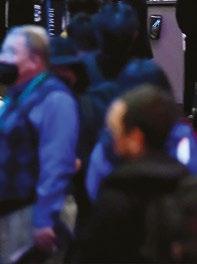

















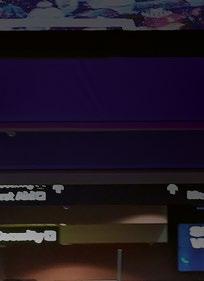










































BUILDING A NEXT-GENERATION M-CDN BALANCING TOOL FOR VIDEO STREAMING
Already leveraging NPAW’s CDN Balancer, European online video streaming service Viaplay was looking for a more flexible multi-CDN load balancing solution to optimise content delivery and costs based on perceived end-user experience and business requirements.
Viaplay and NPAW struck a product improvement partnership to further develop CDN Balancer, turning it into a highly resilient solution to switch between CDNs based on reliable network performance, regional needs, and service-level agreements with CDN providers, all powered by NPAW’s data on end-user experience and video quality
With the new CDN Balancer, Viaplay is able to make the most of its CDN utilisation while ensuring a better viewing experience for its customers. Key advantages for Viaplay include:
• Creating and applying various CDN switching configurations based on a comprehensive set of rules, optimising for quality, price, region, or type of content, among others
• Having a reliable, highly resilient content delivery system that can operate with real-time network and quality of experience data
• Optimise according to CDN volume commitments by minimising peak traffic costs and overage billing
THE NEED FOR SMART MULTI-CDN BALANCING
As Viaplay Group’s premium online streaming service, Viaplay finds itself in the midst of a full-scale international expansion. Having recently launched in the Netherlands, it now has over 5.5 million subscribers around the globe and expects to be available in 21 countries by 2023.

In this context of growth, optimising the delivery of content is a key area of focus for the company.
Working with multiple content delivery network (CDN) providers allows Viaplay to have a more robust content delivery infrastructure to serve its customers, as individual CDNs can be vulnerable to outages and drops in performance. Switching between CDNs results in more reliable availability and higher video quality, major drivers for higher viewer engagement and lower churn.
But how that switching is made is important as well. A smart, data-based balancing tool can greatly increase performance, reduce delivery costs, and lead to greater user satisfaction.
BUILDING CDN BALANCER FOR VIDEO STREAMING
Prior to working with NPAW, Viaplay relied on a CDN balancing system based on the domain name system (DNS), the most common type of load balancing solution available today.
Although easy to implement, DNS-based technologies are mainly meant for static data and have severe limitations when it comes to video streaming. End-user identification is not accurate, CDN performance cannot be tracked in real-time, and they support very few quality of experience switching criteria. Plus, they represent a single point of failure: in the case of DNS failure, the entire balancing system goes down.
Viaplay needed a highly resilient solution built for streaming video on a global scale. The tool should operate in real-time and offer the flexibility to set CDN balancing rules according to the quality of experience and business requirements for each region. To achieve that, Viaplay and NPAW
fed the NPAW Suite’s real-time quality of experience data into the CDN balancing process.



With the new CDN Balancer and its M-CDN Selector, Viaplay now has an API-based balancing solution that can optimise the delivery of content based on the company’s various needs. “We have worked with NPAW to develop a powerful, exible, and resilient multi-CDN balancing solution to meet our business needs. e NPAW team has been very helpful throughout the process, adapting to our needs and bringing in all their quality of experience expertise,” explains Niklas Hammarbäck, product manager at Viaplay
THE BENEFITS OF CDN BALANCER
With CDN Balancer and its multi-CDN Selector tool, Viaplay is able to create and enable di erent CDN balancing con gurations based on a comprehensive set of network rules that permit deep customisation. Viaplay can choose to allow or exclude CDNs based on any combination of network

CASE
cutting down costs and optimising the ful llment of each CDN provider’s quotas. By working with NPAW, Viaplay has also managed to limit throughput per CDN and ISP, reducing peaks in bandwidth demand and being able to have a deeper discussion about service pricing with CDN providers.
“CDN Balancer not only helps us tailor our CDN consumption to each of our audience segments’ needs, but it also lets us control costs and allocate our infrastructure resources in a way that’s not only bene cial for us, but gives our end users a better streaming experience,” adds Hammarbäck. ■

everyone to use.” Eyevinn Technology’s software can be found at https:// github.com/Eyevinn and includes a multiviewer, a proxy to introduce errors to HTTP streams to test players, a test ad server, and a transport stream generator among many others.
MediaInfo is a well-known tool for reading detailed metadata in most media files and has been around for over 20 years. Widely used to get technical details about A/V files and built into asset management workflows, MediaInfo is an open source project from MediaArea. “We want customers to choose us because they trust us and value our skills,” states Jérôme Martinez, digital media analysis specialist at MediaArea. The company also maintains DVRescue which repairs errors in transfers from DV tapes, conformance engine MediaConch and a BWF Metadata editor, all of which were developed for companies who sponsored the development. Martinez continues: “With open source, we don’t hold the keys to the software so customers can use our skills or develop on their own. For a lot of open source developers, open source software is a goal, but for us it is a means.”
The IP showcase saw its debut at IBC 2016. Even while the SMPTE ST 2110 suite of standards was still being drafted, the showcase demonstrated how uncompressed IP can work as well as vendor interoperability. The Video Services Foundation (VSF) first undertook collaborative work describing how to deliver SDI as IP in specifications which later fed into the SMPTE standardisation process. ST 2110 is still being extended and has been the result of work from the global broadcast community. The European Broadcast Union (EBU) was one such contributor and even before 2016 was taking a strong interest in the work. Willem Vermost is the product owner for the EBU Live IP Software Toolkit, also known as LIST, available on the EBU’s open source GitHub repository. “Before ST 2110 was a document, we felt it only made sense that the move to IP should be hand-in-hand with a move to software,” he explains. “But we knew burstiness of IP packets would be much harder without hardware.”
Since its humble beginnings as an excel spreadsheet, LIST has become a live test and measurement tool for timing compliance for ST 2110 and even has an online version which analyses uploaded packet captures. But Vermost explains the tool caused a problem. “It was important for the EBU to stay neutral in its efforts to contribute to ST 2110 and also in our role to bring people together.” Off the back of the first IP Showcase, a regular formal test event, called JT-NM, was devised which would test vendor interoperability. “We used LIST as a tool to get the test and measurement companies together and being open source was a critical part of the strategy. Once this was open source, we were no longer competing with any products and, importantly, we were then able to add definitions to the project,” he adds. As new software came on the market, each product labelled and calculated things differently. “The LIST project became a place to document the formulae and descriptions for common measurements. This collective knowledge will soon be included in the 2110 suite as SMPTE RP 2110-25.”
Part of the benefit of ST 2110 is the separate carriage of the essences needed for uncompressed live production. To control all these media flows, a group of specifications called Networked Media Open Specifications (NMOS) has been developed by the Advanced Media Workflow Association (AMWA) who describe NMOS as “open, industry developed, free of charge and available to everyone”. It’s no surprise, then, that the automated NMOS API Testing Tool is available on AMWA’s GitHub repository but Peter Brightwell, lead R&D engineer at BBC Research & Development, explains that the reasoning is deeper.
“We made some of the BBC’s early NMOS implementations open source to seed community interest,” Brightwell starts. “For a controlplane API such as NMOS, interoperability testing is essential so we started holding regular interoperability workshops.” As more vendors came on board, so the interoperability workshops grew. In fact, the latest interoperability workshop saw 17,000 tests on over 70 devices which is only practical with automation.
Brightwell continues, “Developing the NMOS specifications came to require a large amount of regular manual testing. To remove this and to speed up our interoperability workshops, the automated API Testing Tool was born.” Easy to deploy and controllable by a locally-generated web interface, the ever-growing suite of NMOS specifications such as IS04, IS-05 can be quickly tested. Brightwell concludes, “By open-sourcing the tool, vendors can see exactly how the tests work and what’s more, seeing the code for an NMOS specification can make understanding and implementing NMOS in your own product much quicker.”
A common theme in media and broadcast has been collaboration within the industry using the principle that a rising tide floats all boats. From the standardisation of film that created SMPTE, to the resounding success of SDI and more recently low-latency streaming with CMAF, collaboration has been vital.

The projects discussed here show that not only can open source be part of a business model but that it’s a powerful tool to bring today’s best and brightest to the conversation, to build the future and to help broadcasters and vendors alike swiftly adopt new technology. n

“For a lot of open source developers, open source software is a goal, but for us it is a means” Jérôme MartinezJérôme Martinez Jonas Birmé
HIGH-VOLUME CONTENT
LOCALISATION
Geoff Stedman, CMO, SDVI, takes a look at how a cloud-based media supply chain enables agile resource management to deliver compelling, culturally relevant content

In the modern era of media consumption, content has appeal for audiences if it is relevant to them. No matter where it was created, or by whom, content that is culturally relevant can be consumed and appreciated; and even generate an appetite for more. This is the power of content localisation when done well, and the resulting business opportunity is immense.
Media companies today have countless distribution outlets through which to deliver localised, culturally appropriate content to viewers around the globe (some large media companies have upwards of 600 delivery endpoints). The challenge lies in meeting this massive consumer demand with engaging content, and doing so quickly and cost-effectively.
OPPORTUNITY FOR EFFICIENCY
Content localisation work can include adding secondary language audio tracks, adding secondary language captions or subtitles, adding or modifying graphics or branding to suit the local market, and modifying video to meet local regulations regarding language, nudity, violence, and drug/alcohol use, among others. While some of these tasks can be tedious or routine, others demand artistry. Some can be automated, requiring human intervention only to bring accuracy and quality up to par after the majority of the work has already been completed. Others, such as dubbing, are intensely creative processes that can make all the difference in how well content is received.
Selecting the right talent for a particular dubbing project and managing those resources to deliver a compelling show or movie for the target audience and culture is a vital element of successful localisation. It’s also an example of the human creative processes that traditionally have
been difficult to integrate with automated elements into a seamless media supply chain. This fragmentation has made localisation a costly and timeconsuming process, even a barrier to global media distribution.
Cloud-enabled content localisation is changing all that, making it possible to apply automation and artificial intelligence (AI)- and machine learning (ML)-enabled tools to the challenge, and then to integrate machine activity with various human contributions to the process as content is moved through the media supply chain.

This approach facilitates smart, agile resource management across both processing infrastructure and the various personnel – whether technical staff or actors in a voice studio – that drive completion of a high-quality product. In addition to enabling more effective supply chain management, with much improved visibility and communications across systems and vendors, this model introduces dramatic gains in both flexibility and efficiency.
Media organisations thus can scale localisation processing capacity according to demand, free up more time for critical creative tasks that improve the quality of the end product (and the viewer experience), and accelerate delivery of culturally appropriate movies and TV shows to new and expanding markets worldwide.
CLOUD-ENABLED CONTENT LOCALISATION
Built on cloud infrastructure from a vendor such as AWS, Google, or Microsoft and managed with a cloud-native media supply chain management platform, a modern high-capacity content localisation supply chain leverages various third-party AI tools to perform content analysis that informs and accelerates manual content modification.
The localisation process begins with content receipt, either from an external content producer or from the archive. As media is submitted into the supply chain, the platform inspects the content and extracts technical metadata about the asset, storing it as searchable metadata in the system.
Through integration with order management, traffic/scheduling, or a business contracts system, the media supply chain management platform receives data and orchestrates placeholder creation, asset normalisation, asset validation, and proxy creation. Once programme titles and their requisite metadata, assets, and imagery are centrally organised, content is ready for localisation. (In fact, once assets are in the cloud and managed by the supply chain management platform, a wide range of media analysis engines can be triggered.)
Localisation job requests from the order management, traffic/ scheduling, or business contracts system typically specify factors such as languages needed, the outputs required (subtitles, new language audio tracks, graphics, etc), and the SLA (completion time) desired. Any other requirements specific to the target region and culture (and legal requirements too) are also part of the overall localisation project.
The management platform slots each request into the supply chain queue based on the SLA and provides job details and links to the appropriate content files for download (secured by user account). The authorised service provider, partner, or independent contractor accepts work orders as they come in, selecting the highest priority item first, and provides updates at key milestones or in the event of any roadblocks. For new audio tracks, the provider does the work of finding and recording the talent, providing status updates periodically, and then delivering the finished product. At that point, the management platform integrates the new localised version and continues to the next step defined for the supply chain.
To facilitate efficient manual content modification throughout the localisation process, the management platform leverages cloud-based automated video analysis and detection tools – Amazon Rekognition, Google Video Intelligence, Microsoft Azure Video Analyzer, and VideoAI from Comcast Technology Solutions – to gather information about the nature of content. Providing AI- and ML-powered analysis capabilities, these tools automatically perform tasks such as object, scene, and activity identification; text detection; and face detection and analysis. Metadata associated with any desired result (nudity, inappropriate language, alcohol, etc) is harmonised by the supply chain management platform, which then initiates a work order for manual review by a QC operator or compliance editor.
Because it is time-based, this metadata guides the editors to scenes that might need moderation or modification. The supply chain management platform presents all detected items in a custom panel within Adobe Premiere Pro or Accurate.Video Edit, allowing editors to move quickly from scene to scene as needed to make necessary edits. (This guided process can reduce by 80 per cent the time it takes to create approved versions of localised content.) Once again, when the work order is marked complete, the platform registers it as finished, updates the status of the asset, and moves the content on to the next step in the supply chain.
With this scalable model for content localisation, media organisations can be more effective and efficient in leveraging all of their resources toward creation of engaging, culturally appropriate content. Taking advantage of cloud-based media supply chains, they can employ the latest and greatest
AI-driven processing tools and improve their efficiency in managing the human and creative elements of localisation. Moving away from the highly fragmented manual models of the past, media organisations can implement more agile workflows, with the flexibility to produce as many versions of content as different audiences and markets require.
THE CLOUD LOCALISATION BLUEPRINT
A great example of putting this all together is the Cloud Localisation Blueprint (CLB) unveiled at IBC 2022 show as part of the IBC Accelerator Programme. It documents an end-to-end cloud localisation workflow and codifies implementation so that it can be deployed quickly and in a repeatable manner. The blueprint is intended to give media organisations more formal instruction and documentation as they make the shift to this new model. “The economic prize of technological transformation is potentially enormous,” it states, and “this blueprint intends to serve as a guide on how to get there.”
Developed by a core group of companies primarily to outline best practices and key considerations for building a cloud-based media supply chain for content localisation, the blueprint is presented as a model implementation. It provides a well-documented architecture and established integrations that can be adopted with confidence to build an ideal supply chain. But in keeping with the notion that the cloud brings agility and choice, the blueprint also gives media organisations the flexibility to work with the systems that best suit their preferences and requirements. Organisations can take advantage of automation when they need it, access service providers that connect to human talent, and manage all that within a system with end-to-end visibility they’ve never had before.
The CLB is a remarkable achievement and a valuable resource for any organisation seriously considering smart, scalable ways to move forward in meeting today’s massive demand for localised content. The document includes a hypothetical scenario with Warner Bros Discovery licensing content from Pokémon for international presentation in six countries on the HBO Max platform, and it’s a comprehensive exploration of all the processes involved in content localisation, from rights management through compliance. For organisations ready to take a deep dive into the subject, it’s worth reviewing. It’s certainly a strong example of the multivendor collaboration and platform integration that needs to happen to support media organisations in meeting the requirements of a high-volume content localisation workflow.
CREATING THE CONSUMER EXPERIENCE
While content is typically perfected for its target audience when it’s first created, a nicely localised piece of content can provide a compelling consumer experience for a whole new audience. Once people find that content, the quality of localisation contributes to retention; how willing viewers are to keep watching or go looking for more.
A cloud-enabled media supply chain gives media organisations the ability to manage all essential contributors to effective localisation –machine activity and human technicians and creatives – in an efficient manner, with visibility into each step of the workflow. Using the cloud to scale capacity and media supply chain management to ensure efficiency, organisations can respond quickly to worldwide demand for engaging entertainment experiences. n
#INSPIRE, #EDUCATE, #INFORM
Carrie Wootten, managing director of Rise, is a leading advocate of diversity in the media technology industry. She explains why now is the time to go out and get the next generation of talent... because its there!

How did you get started in the media tech industry?
I studied drama and theatre studies at university and went on to radio and television roles from there. But the real change was when I joined Ravensbourne University as their head of commercial development and partnerships in 2009, where I started to work more closely with broadcast engineers across the sector.
How has it changed since you started your career?
The discussion around diversity has changed tenfold since then. There are open and transparent conversations around the lack of diversity in our sector; but as we know, there is still so much work to do to translate this into concrete action across the industry.
What makes you passionate about working in the industry?
The potential of what could be! It’s such a dynamic, exciting, innovative industry, with incredible people in it. But we need to ensure it’s a diverse and inclusive sector too.
If you could change one thing about the media tech industry, what would it be?
The speed at which we’re changing the gender diversity of our sector. We’re just not moving fast enough and as Tim Cook recently said, there are no more excuses now.
How inclusive do you think the industry is, and how can we make it more inclusive?
I think some companies are trying really hard, some not so much and some struggle to understand how to be more inclusive. I had a conversation with a company recently that hadn’t thought about ensuring diversity was represented on their website or that their maternity policies were easily found. Small changes make a big difference. Ensuring there are open, transparent and honest conversations around diversity internally are vital; being open to the suggestions that staff make around inclusivity, and that these are supported from the executives. This is absolutely critical. Our Strive to Rise Mark also now provides a framework for companies to self-assess where they are with gender
diversity, so hopefully this will help media businesses understand how to create and build more inclusive environments.
How do we get the message out to young people that media technology is the career for them?
We know that our workshops and Summer Schools have a big impact on young people (and crucially their parents) on how they view and engage with the media technology industry. We must spend time and resources to #inspire #educate and #inform them about their potential pathways and opportunities in the sector. For too long we have waited for talent to come to us; we now need to go out and get it, because it’s definitely there!
Where do you think the industry will go next?
I don’t think the explosion in innovation has anywhere near petered out, and the ongoing development around 5G utilisation, cloud technology and remote production is going to continue to thrive. I think the demand for content will still outstrip what we’ve seen before, and the development of new agile, start-ups will continue to find ways to produce new products to challenge and disrupt the supply chains. Exciting times!
What’s the biggest topic of discussion in your area of the industry?
Is it enough? Rise has achieved an incredible amount in the short time it has been running, but this question keeps me up at night. Is it enough? How do we do more? When can we do more? And who/what do we need to have in place to achieve this. The job is not done, until we can walk into any trade show across the globe and see that gender representation on the show floor.
What should the industry be talking about that it isn’t at the moment?
How we collectively move quickly enough. This isn’t a one company problem/solution. We all have to work collectively and collaboratively if we’re going to address diversity and other big areas such as sustainability. These are central elements to our survival as a sector and we’ll only do this through the ultimate teamwork. n


